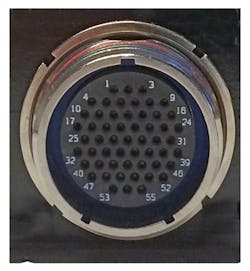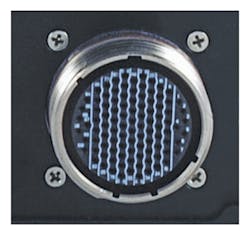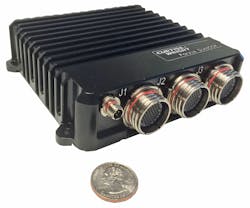Balancing Processing Power and Reliability in Micro-Mini Mission Computers
This file type includes high-resolution graphics and schematics when applicable.
Efforts to optimize the miniaturization of mission processor systems used onboard deployed commercial and military platforms, such as unmanned airborne and ground vehicles, is being driven by a combination of market demand and enabling technologies. But what constitutes optimal size, weight, and power (SWaP) for a mission computer varies greatly depending on the target platform and application. In the commercial unmanned-aircraft-system (UAS) market, suppliers such as Facebook, Google, and Amazon are developing business models around UAS platforms that in some cases are only nominally larger in scale than hobbyist drones.
Payload Size is Key
The context for SWaP in the UAS space, whether commercial or military, is typically dictated by the size of the payload that a platform can carry. The platform’s mission is often driven by the capabilities brought by the payload. For example, in contrast to the small commercial UASs, consider a military high-altitude long-endurance (HALE) platform that can carry 500 or 1000 pounds of payload electronics. These platforms are often being used for persistent intelligence, surveillance, and reconnaissance (ISR) use cases.
In comparison, the small commercial UAS more typically may have a 0.5-lb. payload capability. Designers of these systems may be satisfied to get an HD camera onboard their UAS that flies for only about 30 minutes due to the limitations of the aircraft’s battery. For such small platforms, both airborne and ground, micro-miniaturization of mission computers becomes very desirous.
The Thermal-Management Challenge
When determining their mission-computer processing requirements, system designers must consider the system’s weight and the heat generated by its processors. The processors’ heat dissipation can limit their use or complicate thermal management and cooling.
An enabling technology in this area is the recent introduction of lower-power multicore processors that come in systems-on-chip (SoCs), either in the ARM or x86 variety. These breakthrough devices are helping to drive new module form factors that are pluggable into commercial and military embedded systems. Computer modules, particularly based on the PICMG standard COM-Express, are rising in popularity in the embedded space.
Another smaller standard, aimed at processors that are 10 W or below, is SMARC ("Smart Mobility ARChitecture"), which is published by the Standardization Group for Embedded Technologies (SGET). These small-computer-on-module standards are enabling COTS vendors to miniaturize the size of highly reliable, rugged mission computers by using processors with greatly minimized thermal-management challenges.
Shrinking Connectors
Another limiting factor when attempting to optimize SWaP has been the use of traditional MIL connectors. Their size and weight often drives the end size of the mission computer. The resulting box has needed to be as tall and/or as wide to accommodate the required connectors.
Human engineering considerations play a role, too. The user needs to be able to easily mate a cable up to a connector. Therefore, connectors need to be spaced appropriately so that the user’s fingers can fit in between adjacent connectors. As a result, the spacing and physical size of connectors has made it difficult to shrink the size of mission computer boxes.
To combat this problem, many manufacturers of rugged connectors are coming out with micro-miniature versions of the most popular connectors. The MIL-DTL-38999 connector has long been adopted within the military. Today, versions of that connector, patterned on the performance and general look-and-feel of the original, provide higher density. The new connectors (Fig. 1) shrink by half the weight and size of the traditional MIL-DTL-38999 (Fig. 2), yet deliver the same or better electrical and environmental characteristics.
Ensuring High Reliability
A parallel focus and design challenge while endeavoring to develop micro-miniaturized systems is to retain the high reliability expected by customers. The system must be analyzed holistically, considering not only the mechanical and physical aspects of the target platform, but also from an environmental and electromagnetic-interference (EMI) standpoint. The system must be able to perform reliably across extended temperature ranges and handle the high shock and vibration environments that are common in airborne and ground vehicles. Also, the system must be designed so that it doesn’t emit EMI that would compromise any other systems onboard the platform. It must also be immune to radiated noise coming from any of the other onboard systems.
At a system level, the host carrier board for computer-on-modules must be designed to handle the thermal interfaces to the system chassis. It must also be able to deal with the shock and vibration considerations from different axes and orientations. What’s more, because customers today have unique and varied I/O requirements, a degree of modularity should be provided so that I/O functionality can be added in an intelligent way.
The ultimate goal is that the mission computer’s functionality gives the customer a solution that meets all platform requirements. From a performance standpoint, the mission computer needs to have the appropriate connectors and address the potential ingress of EMI/dust/water/humidity/corrosion/altitude, as well as thermal and shock and vibration considerations.
One ultra-small mission computer that takes performance and high reliability lessons learned from defense applications, which also apply to many commercial systems, is Curtiss-Wright’s new Parvus DuraCOR 310 mission computer (Fig. 3). It’s 75% smaller than traditional mission computers and approximately 50% lighter than Curtiss-Wright’s previous smallest rugged mission computer.
This ultra-small-form-factor (USFF) mission processor features a very-low-power quad-core ARM microprocessor and I/O expansion using Mini PCI-Express modules. It’s designed to meet demanding MIL-STD-810G, MIL-STD-461F, MIL-STD-1275D, MIL-STD-704F, and RTCA/DO-160G environmental, power, and EMI standards. It features an NXP Semiconductor (formerly Freescale) i.MX6 ARM processor on an industrial-grade computer-on-module tightly integrated with a flash SSD. The unit weighs less than 1.5 lb., measures only ~39 in.³ volume (est.), requires less than 10 W of power, and supports an ambient operating temperature range of –40 to +71°C (–40 to +160ºF) without fans or active cooling requirements.
Using enabling technologies, such as micro-miniature connectors, low-power multicore processors, and new form factors such as computer-on-modules, we can now build next-generation rugged subsystems that meet the unique demands of unmanned platforms, rotorcraft, and other applications where size, weight, power, and cost are a premium.
Looking for parts? Go to SourceESB.
About the Author
Mike Southworth
Product Marketing Manager
Mike Southworth serves as Product Marketing Manager for Curtiss-Wright Defense Solutions, where he is responsible for the small-form-factor rugged mission computers and Ethernet networking subsystem product line targeting size, weight, and power (SWaP)-constrained military and aerospace applications. Southworth has more than 15 years of experience in technical product management and marketing communications leadership roles. Mike holds an MBA from the University of Utah and a Bachelor of Arts in public relations from Brigham Young University.





